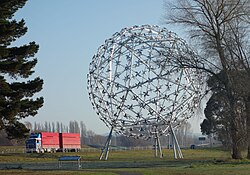|
Kainga, New Zealand
Kainga is a settlement on the southern bank of the Waimakariri River, just north of Christchurch, in Canterbury, New Zealand. It lies immediately to the south of Kaiapoi, on a small road leading northeast from State Highway 1.[3] Originally established as a small group of fishing huts on the south side of the Waimakariri, it later developed into a small residential area.[4] A small forestry plantation lies to the southeast of the settlement.[3] DemographicsKainga is in an SA1 statistical area which covers 2.37 km2 (0.92 sq mi).[1] The SA1 area is part of the larger Styx statistical area.[5]
The SA1 statistical area had a population of 195 at the 2018 New Zealand census, a decrease of 6 people (−3.0%) since the 2013 census, and unchanged since the 2006 census. There were 81 households, comprising 105 males and 93 females, giving a sex ratio of 1.13 males per female. The median age was 39.6 years (compared with 37.4 years nationally), with 36 people (18.5%) aged under 15 years, 33 (16.9%) aged 15 to 29, 105 (53.8%) aged 30 to 64, and 21 (10.8%) aged 65 or older. Ethnicities were 93.8% European/Pākehā, 16.9% Māori, 3.1% Pasifika, 1.5% Asian, and 1.5% other ethnicities. People may identify with more than one ethnicity. Although some people chose not to answer the census's question about religious affiliation, 75.4% had no religion, 16.9% were Christian, 1.5% had Māori religious beliefs and 1.5% had other religions. Of those at least 15 years old, 15 (9.4%) people had a bachelor's or higher degree, and 48 (30.2%) people had no formal qualifications. The median income was $31,200, compared with $31,800 nationally. 15 people (9.4%) earned over $70,000 compared to 17.2% nationally. The employment status of those at least 15 was that 84 (52.8%) people were employed full-time, 24 (15.1%) were part-time, and 6 (3.8%) were unemployed.[2] References
|
|||||||||||||||||||||||||||||||||||||||||||||||||||||||||

